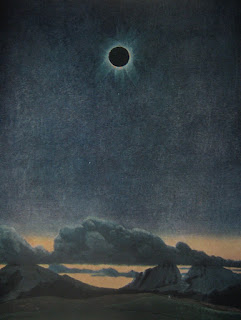Solar Eclipse Paintings

There was an art show as part of multicultural night at our daughter’s school last night. This inspired me to post this about eclipse paintings. There are lots of photographs of total solar eclipses, especially recently. In the past, a few skilled artists painted solar eclipses. Take this one, for example: source: http://palomarskies.blogspot. com/ In 1937, the artist D. Owen Stephens joined an expedition to the Andes Mountains in South America to record the total eclipse on June 8. His artistic skill was evident in his painting of the beautiful spectacle. Astronomer George Lovi once commented on the painting: "I've seen many photographs showing the sky and horizon during totality. Yet to me not one has captured the true appearance, ambiance, and mood of the event as well as by D. Owen Stephens painting showing the June 8, 1937 total eclipse, for which he traveled to a 14,600-foot mountaintop in the Peruvian Andes. Stephens portrayed the very delicate corona wonderful...